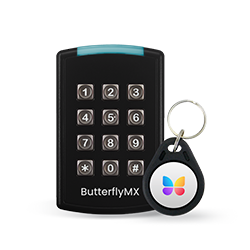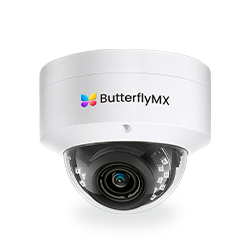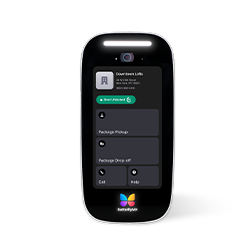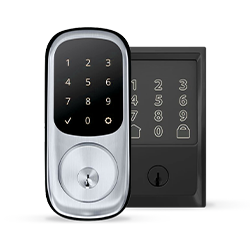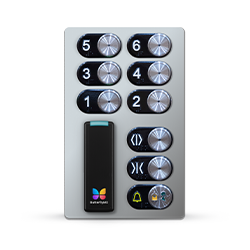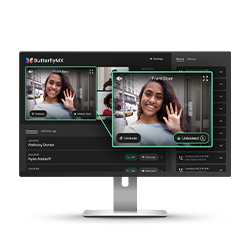Key takeaways
- Keyless entry systems improve security and convenience by replacing traditional keys with mobile apps, PIN codes, key fobs, or biometrics.
- Both businesses and residential properties benefit from enhanced security, streamlined access management, and a better user experience.
- Different keyless entry options cater to various needs, including keypad entry, key fobs, mobile-based access, and biometric authentication.
- Seamless integration with smart technology allows for remote access management, real-time tracking, and enhanced security oversight.
- A scalable and user-friendly keyless entry system simplifies property access while eliminating the risks of lost or duplicated keys.
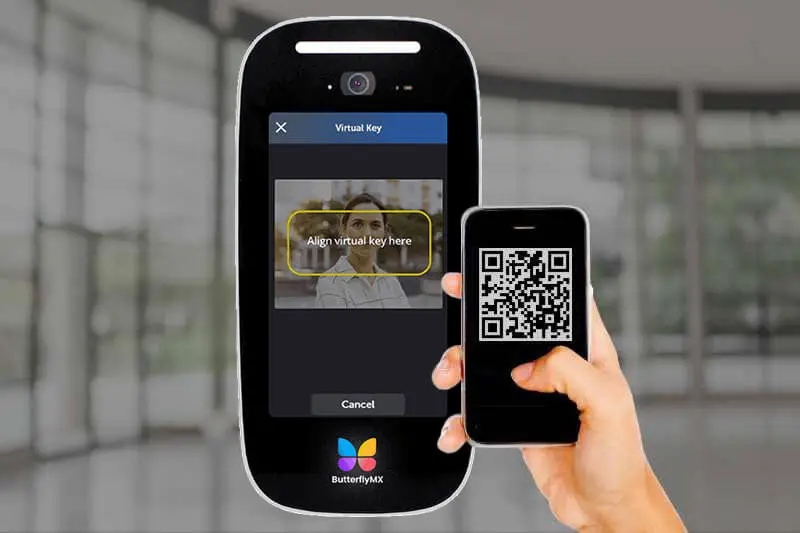
A keyless entry system is a modern access control solution that eliminates the need for traditional keys, offering convenience, security, and flexibility for both commercial and residential buildings. Whether you manage an office, apartment complex, or retail space, upgrading to a keyless door entry system allows for remote access, better security, and seamless integrations with smart technology.
But with so many options available, it’s important to understand which system best fits your needs. In this guide, we’ll break down the different types of keyless entry systems, their benefits, and key factors to consider when choosing the right one.
This post covers:
- What is a keyless entry system?
- How do keyless entry systems work?
- Types of keyless entry systems
- Keyless entry for businesses & commercial buildings
- Keyless entry for apartments & residential properties
- Benefits of keyless entry systems
- Types of doors suitable for keyless entry systems
- Factors to consider when choosing a keyless entry system
- Installation & maintenance of keyless entry systems
- Real-world applications of keyless entry systems
- Why choose ButterflyMX for your keyless entry needs?
- Keyless entry system FAQs
More than 40K, 5-star reviews!
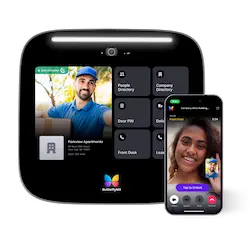
Video Intercoms
Open doors, gates & garages from anywhere.
Access Control
Fob, key cards, PINs, and mobile apps.
Security Cameras
Visibility throughout your property.
Vehicle Access
Hands-free access for gates & garages.
Package Room
Receive, store, and manage deliveries.
Smart Locks
Connect to all major brands and models.
Elevator Controls
Unlock key-fobbed elevators for anyone.
Front Desk Station
See all your doors and cameras in one place.
What is a keyless entry system?
A keyless entry system is a modern access control solution that allows people to unlock doors without traditional keys, using methods like PIN codes, key fobs, mobile apps, or biometric authentication.
Unlike outdated lock-and-key systems, keyless entry provides a seamless, secure, and flexible way to control access to commercial buildings, apartment complexes, and businesses. Instead of worrying about lost or copied keys, property owners and managers can grant or revoke access remotely, keeping their buildings more secure.
Why keyless entry is the future of access control
As security technology evolves, more properties are switching to keyless entry systems because they offer better control, stronger security, and enhanced convenience. Keyless entry solutions reduce the risk of unauthorized access, eliminate the hassle of key replacements, and allow for audit trails that track who enters and exits a building.
For businesses, this means improved employee and visitor management, while for residential buildings, it enhances tenant experience and property value.
How keyless entry improves security & convenience
For businesses, keyless entry systems help secure office buildings, warehouses, and retail spaces by offering custom access schedules and centralized control. Employees and visitors can enter designated areas using mobile credentials or PIN codes, ensuring that only authorized individuals can access specific parts of the building.
For residential properties, keyless entry makes life easier for tenants and property managers by enabling remote access, guest management, and seamless integration with smart home technology. Features like one-time access codes for visitors or package deliveries improve security while reducing operational headaches.
Seamless integration for any property type
The right keyless entry system for businesses and residential buildings should offer scalability, security, and ease of use. Whether you need to manage a large office, a gated community, or a high-rise apartment, modern keyless solutions integrate seamlessly with intercoms, security cameras, and access management platforms.
How do keyless entry systems work?
A keyless entry system replaces traditional keys with electronic access methods, allowing users to unlock doors using mobile apps, PIN codes, key cards, or fobs. These systems are controlled by cloud-based or on-premise software, which enables property owners and managers to grant, revoke, or track access in real-time.
Access methods for keyless entry systems
- Mobile apps. Users can unlock doors from their smartphones, providing secure, remote access without needing a physical key or fob.
- PIN codes. Unique passcodes grant access to authorized individuals, ideal for short-term guests, employees, or maintenance staff.
- Key cards & fobs. These RFID-enabled credentials allow quick access with a simple tap or swipe, commonly used in offices, multifamily buildings, and gated communities.
- Bluetooth & NFC. Mobile devices can communicate with access points via Bluetooth or near-field communication (NFC) for hands-free entry.
Benefits of digital access vs. traditional locks
- Stronger security. Unlike physical keys that can be lost or copied, digital credentials can be revoked instantly, reducing the risk of unauthorized entry.
- Remote access management. Property managers can grant or deny access from anywhere, eliminating the need for in-person key exchanges.
- Audit trails & activity logs. Many systems keep detailed logs of who enters and exits, providing better security oversight and compliance tracking.
- Convenience & flexibility. No more rekeying locks when tenants move out or employees leave, simply update access permissions digitally.
Watch how ButterflyMX works:
Types of keyless entry systems
Choosing the right keyless entry system depends on the type of property, security needs, and user experience. Whether you’re securing a commercial building, multifamily property, or residential home, different access methods provide varying levels of convenience, scalability, and security.
The most common types of keyless entry systems include:
- Keypad entry systems
- Key fob & card entry systems
- Smart locks
- Mobile-based entry
- Biometric & facial recognition access
Keypad entry systems
Keypad entry systems require users to enter a PIN code to gain access. These systems can be standalone or integrated with a broader access control platform, making them a simple yet effective solution for both residential and commercial properties.
Best for:
- Apartment buildings. Secure entry for tenants and guests.
- Small businesses. Employees can use PINs instead of physical keys.
- Gated communities. Ideal for visitor and delivery access.
Features:
- No physical credentials needed (reduces lost keys or fobs).
- Easy to change codes for temporary or scheduled access.
- Affordable and simple to install.
Key fob & card entry systems
These systems use RFID-enabled key fobs or access cards that tap or swipe against a reader to unlock doors. They are widely used in commercial buildings, offices, and multifamily properties because they provide a balance of security and convenience.
Best for:
- Commercial buildings & office spaces. Provides quick, controlled access for employees.
- Multifamily properties. Tenants can access shared spaces like lobbies, elevators, and gyms.
- Coworking spaces & short term rentals. Efficient for managing temporary or rotating occupants.
Features:
- Quick and easy access with a simple tap or swipe.
- More secure than traditional keys because fobs/cards can be deactivated remotely.
- Works well for large-scale properties with multiple doors.
Smart locks
Smart locks are WiFi or Bluetooth-enabled locks that allow users to control access via a smartphone app, PIN code, or voice command. They are ideal for smaller residential properties and short-term rentals, where landlords or homeowners need to grant remote access to guests or tenants.
Best for:
- Residential homes & condos. Homeowners can lock/unlock doors via a mobile app.
- Short-term rentals. Hosts can provide guests with temporary PINs.
- Small businesses & storefronts. Allows owners to grant access remotely.
Features:
- Eliminates physical keys, reducing lockouts and rekeying costs.
- Allows for temporary or scheduled access (great for guests, cleaners, or deliveries).
- Some models integrate with smart home ecosystems (Alexa, Google Assistant).
Mobile-based entry
Mobile-based entry systems eliminate the need for physical credentials altogether, allowing users to unlock doors with their smartphone via an app. These systems typically use WiFi, Bluetooth, or cloud-based access control, making them the most advanced and flexible solution for modern properties.
Best for:
- Commercial buildings & offices. Employees can access the building using their phones.
- Apartment complexes. Tenants can open doors from anywhere via an app.
- Gated communities & secure parking garages. Provides controlled entry without key fobs.
Features:
- Secure and harder to duplicate than key fobs/cards.
- Allows for remote access management (no need for on-site staff).
- Seamlessly integrates with other security systems (intercoms, cameras, visitor logs).
Biometric & facial recognition access
Biometric keyless entry uses fingerprints, retina scans, or facial recognition to verify user identity. While this method is gaining popularity, it is mostly used in high-security environments such as government buildings, data centers, and corporate headquarters.
Best for:
- High-security businesses & government facilities. Ensures only authorized personnel can enter.
- Corporate headquarters. Provides extra security layers for sensitive areas.
- Luxury residential buildings. Used for premium concierge-level access control.
Features:
- Extremely secure. Access is unique to each person.
- Eliminates the need for physical credentials (no cards, fobs, or PINs).
- Provides fast, touchless entry.
Keyless entry for businesses & commercial buildings
For commercial properties, offices, and businesses, security and access management are top priorities. Traditional keys create security risks, operational inefficiencies, and costly rekeying processes when employees leave or lose access.
Why commercial properties benefit from keyless entry
Higher security & controlled access
Keyless entry systems reduce unauthorized access and security risks by replacing traditional keys with mobile credentials, key fobs, or PIN codes. Unlike physical keys, which can be copied or stolen, digital credentials can be revoked instantly, preventing security breaches. Many systems also allow businesses to customize access levels, ensuring only employees with the proper authorization can enter certain areas, such as IT rooms, executive offices, or storage areas.
Employee & visitor management
Managing employee access with traditional keys can be a logistical nightmare. A keyless entry system for commercial buildings enables remote access management.
Keyless entry systems allow property managers and business owners to:
- Grant access on a schedule. Employees can enter only during their designated shifts.
- Issue temporary PINs or mobile credentials. Perfect for contractors, vendors, and temporary workers.
- Automatically revoke access. No need to retrieve keys from former employees or update locks.
For visitor management, keyless entry systems allow businesses to provide one-time access codes or send digital guest passes, eliminating the need for physical key handoffs.
Audit trails & compliance
Businesses often require detailed access logs for compliance, safety, and liability purposes.
With cloud-based keyless entry systems, property managers can:
- Track entry logs in real-time, seeing who enters and exits specific doors.
- Generate audit reports for security compliance and internal policies.
- Enhance workplace security by monitoring visitor access and potential security risks.
This is particularly beneficial for industries with strict security regulations, such as finance, healthcare, and data centers.
Best keyless entry solutions for businesses
The right commercial building keyless entry system depends on the size, structure, and security needs of the business. Here are the most effective solutions.
Mobile-based entry
- Employees unlock doors using their smartphones via an app.
- Eliminates the need for key fobs or cards.
- Enables remote access management & visitor access control.
- Best suited for: Large office buildings, coworking spaces, multi-tenant commercial properties.
Key fob & card systems
- Employees tap/swipe a key fob or card to gain entry.
- Easy to manage but requires fob/card issuance and replacements.
- Best suited for: Small to mid-sized businesses, commercial buildings with multiple tenants.
PIN code & keypad systems
- Users enter a unique PIN code instead of using a physical credential.
- Ideal for granting temporary or scheduled access to employees and vendors.
- Best suited for: Small businesses, storage facilities, maintenance rooms.
Biometric & facial recognition
- Uses fingerprints or facial recognition for access.
- Provides the highest level of security but comes at a higher cost.
- Best suited for: Data centers, corporate headquarters, government buildings.
Keyless entry for apartments & residential properties
For apartment buildings, multifamily communities, and residential properties, keyless entry systems offer enhanced security, convenience, and a modern living experience. Tenants expect seamless, smartphone-based access that eliminates the hassle of carrying keys, while property managers benefit from remote access control and simplified operations.
Upgrading to a residential keyless entry system improves tenant satisfaction, increases property value, and streamlines visitor and delivery management.
- How keyless entry enhances resident experience & property value
- Keyless entry benefits for property managers
How keyless entry enhances resident experience & property value
- Seamless, key-free access. Tenants can unlock doors using their smartphone, PIN codes, or fobs, eliminating lost key issues.
- Improved security. No risk of lost, stolen, or duplicated keys, reducing unauthorized access.
- Convenience for guests & deliveries. Residents can provide temporary access codes for visitors, cleaning services, or package deliveries.
- Higher property value. Buildings with modern keyless entry systems are more attractive to renters and buyers, increasing leasing demand and ROI.
Keyless entry benefits for property managers
Remote access management
Traditional key management is a logistical nightmare: lost keys, lock replacements, and on-site key handoffs waste time and resources.
With a cloud-based keyless entry system, property managers can:
- Grant or revoke access remotely (no need for on-site staff).
- Issue temporary credentials for maintenance teams, vendors, and cleaning services.
- Schedule access permissions (e.g., restricting entry to service providers only during business hours).
A keyless system eliminates the hassles and costs of rekeying while ensuring tight security and efficient access control.
Guest & delivery access
One of the biggest challenges for apartment buildings is managing guest and delivery access without compromising security.
A residential keyless entry system allows property managers and residents to:
- Send Visitor Passes or PIN codes to visitors, guests, or Airbnb tenants.
- Integrate with video intercoms to visually verify visitors before granting entry, creating a unified video door entry system.
- Enable seamless package deliveries by providing controlled access to couriers.
Smart home & IoT integrations
Your residents expect every component of their home to be connected. This can be achieved through integrations.
Keyless entry systems can be part of a larger smart home ecosystem, integrating with:
- Smart locks for individual apartments. Tenants can lock/unlock their doors via an app.
- Building-wide access control. Connect keyless entry with elevator controls, parking garages, and fitness centers.
- Security cameras & access logs. Keep a detailed history of who enters/exits for added security.
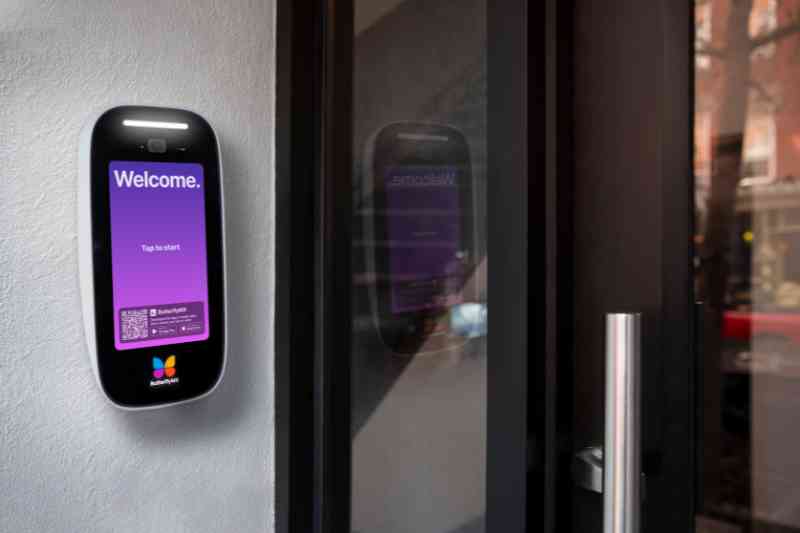
Benefits of keyless entry systems
Switching to a keyless entry system offers a range of advantages for businesses, multifamily properties, and residential communities. Beyond eliminating the hassle of physical keys, keyless systems provide stronger security, improved convenience, and long-term cost savings.
Here are the benefits of keyless entry for buildings:
Increased security
Traditional keys are easily lost, stolen, or duplicated, making buildings more vulnerable to unauthorized access. Keyless entry eliminates this risk by replacing physical keys with digital credentials, such as mobile apps, PIN codes, or key fobs.
- Instant credential management. Property managers can grant or revoke access remotely, ensuring only authorized individuals can enter.
- Encrypted access. Mobile-based and cloud-connected keyless entry systems use encrypted credentials, reducing the risk of hacking or duplication.
- Audit trails & access logs. Many commercial building keyless entry systems provide real-time logs of who enters and exits, improving security and compliance.
Convenience & flexibility
One of the biggest advantages of keyless entry systems for businesses and apartments is flexibility. Unlike traditional locks that require in-person key handoffs, digital access can be managed remotely, making property access more efficient.
- Remote access control. Open doors from anywhere using a smartphone app.
- Scheduled entry. Set access permissions for employees, guests, or contractors, allowing entry only during designated hours.
- Frictionless tenant & guest experience. Tenants can enter without digging for keys, while visitors can receive temporary PINs or mobile guest passes.
Cost savings over time
Traditional lock-and-key systems require costly maintenance, including rekeying locks every time a tenant moves out or an employee leaves. With a keyless entry system, these recurring expenses are eliminated.
- No more rekeying costs. Digital credentials can be updated instantly, reducing expenses on lock changes and key replacements.
- Lower labor costs. Eliminates the need for on-site staff to handle key distribution or rekey locks.
- Fewer lock replacements. Keyless locks are more durable than traditional locks, reducing long-term maintenance costs.
Scalability
For growing businesses and expanding multifamily properties, keyless entry systems provide scalability that traditional keys simply can’t match. Whether managing a single office, a high-rise building, or a national portfolio of properties, keyless access control adapts as your needs evolve.
- Multi-door & multi-building access. Scale your access control system as your property grows.
- Cloud-based management. Manage access remotely across multiple locations from one platform.
- Seamless integrations. Connect keyless entry with security cameras, intercom systems, and visitor management platforms.
Types of doors suitable for keyless entry systems
A keyless entry system isn’t just for front doors, modern access control solutions can be implemented across various entry points, ensuring security, convenience, and operational efficiency.
Main entrances
The main entrance is the first line of defense for any building. Ensuring that only authorized individuals, tenants, employees, or approved visitors, can enter is crucial for security and operational efficiency.
Best keyless solutions for main entrances:
- Mobile-based entry. Tenants and employees can unlock doors with their smartphone app.
- Video intercom systems. Visitors and deliveries can request access remotely.
- Key fob & card readers. Ideal for multi-tenant office buildings and apartment complexes.
- Biometric & PIN code access. Provides an added layer of security for high-traffic commercial lobbies.
Interior doors
Not all areas within a building should be accessible to everyone. Interior keyless entry systems allow businesses and property managers to restrict access to specific rooms or departments, ensuring that only authorized personnel can enter.
Best keyless solutions for interior doors:
- Keypad & PIN entry systems. Common for shared office spaces, conference rooms, and co-working areas.
- Mobile-based entry. Employees can unlock doors with their smartphone app, making access frictionless.
- Biometric access control. Ideal for data centers, IT rooms, and executive offices.
Gates & parking access
For commercial buildings, gated communities, and industrial properties, securing parking garages and loading docks is just as important as securing main entrances.
Best keyless solutions for gates & parking access:
- Mobile-based entry & Visitor Passes. Tenants and employees can open gates remotely via an app.
- License plate recognition (LPR) systems. Vehicles with registered license plates are granted automatic entry.
- RFID or proximity fobs. Used for employee parking garages or private gated communities.
- Temporary PINs for deliveries. Delivery drivers can be granted limited-time access to loading docks and service entrances.
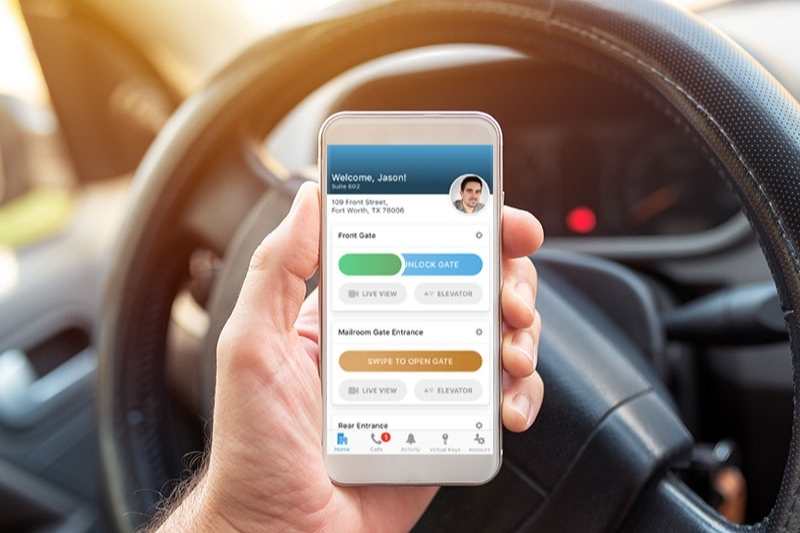
Factors to consider when choosing a keyless entry system
Selecting the right keyless entry system for your commercial or residential property requires careful consideration of several key factors.
These factors include:
Scalability
A commercial building keyless entry system should be able to scale as your property expands.
Your keyless system should:
- Support multiple entry points. Ensure the system can manage multiple doors, buildings, and access points from a single platform.
- Handle high user volumes. Large properties with hundreds or thousands of tenants and employees need a system that efficiently manages digital credentials.
- Allow for future upgrades. Look for cloud-based solutions that can integrate with emerging access technologies over time.
Security & compliance
Security is one of the most critical factors when choosing a keyless entry system for businesses or residential properties.
The system should protect against unauthorized access by offering:
- End-to-end encryption. Ensures digital credentials (PINs, mobile keys, or biometric data) are secure and cannot be cloned or intercepted.
- Multi-factor authentication (MFA). Some systems offer dual authentication for high-security areas (e.g., requiring both a mobile key and a PIN).
- Regulatory compliance. Depending on your industry, ensure the system meets security standards like GDPR, HIPAA, or PCI DSS for data protection.
Integration capabilities
The best commercial and residential keyless entry systems seamlessly integrate with other security and property management technologies.
Look for solutions that connect with:
- Video intercoms & security cameras. Enhances visitor verification before granting access.
- Building management software. integrates with tenant directories, leasing platforms, and staff scheduling systems.
- Smart locks & IoT devices. Enables cross-functionality with smart lighting, HVAC, and automation tools for a fully connected property.
Ease of use & management
A keyless entry system should simplify access management, not complicate it.
Property managers, tenants, and employees need an intuitive, user-friendly system that:
- Provides remote access control. Allows property managers to grant, revoke, or modify access credentials from anywhere.
- Offers a seamless user experience. Mobile-based systems should have easy-to-navigate apps for tenants and staff.
- Includes automated reporting & alerts. Sends real-time access notifications and logs to security teams.
Installation & maintenance of keyless entry systems
Installing a keyless entry system is a major step toward improving security, convenience, and operational efficiency in commercial and residential properties. However, successful implementation requires careful planning, proper installation, and ongoing maintenance to ensure seamless operation.
Installation considerations: wired vs. wireless systems
Before installing a keyless entry system, property owners and managers must evaluate compatibility with existing infrastructure, determine whether a wired or wireless setup is best, and plan for optimal access point placement.
Wired keyless entry systems:
- Hardwired systems connect directly to the building’s electrical and security infrastructure.
- Best for large commercial properties, high-security areas, and long-term installations.
- Provides stable, uninterrupted access control but may require more extensive installation time and costs.
Wireless keyless entry systems:
- Operate via WiFi, Bluetooth, or cellular connections, making installation faster and more flexible.
- Ideal for multifamily buildings, offices, and smaller commercial spaces that require scalability.
- Easier to integrate with smart access platforms and mobile-based entry solutions.
System maintenance & updates: ensuring long-term reliability
A commercial building keyless entry system should require minimal physical maintenance, but regular software updates and system monitoring are crucial to keeping the system secure and efficient.
- Cloud-based updates. Cloud-connected keyless systems receive automatic software updates, ensuring security patches and new features are applied without requiring on-site service.
- Credential management. Administrators should regularly review access logs to identify unauthorized attempts and revoke unused credentials.
- Battery & hardware checks. Wireless keyless entry systems depend on battery power, so regular maintenance should include checking power levels on smart locks, keyless door knobs, readers, and access control panels.
- 24/7 support & redundancy. Choose a system provider that offers customer support and backup access solutions in case of network or power failures.
User training & onboarding: ensuring seamless adoption
A keyless entry system is only effective if users, tenants, employees, and building managers understand how to use it properly. A structured onboarding process improves adoption rates and minimizes security risks.
Educating tenants & employees
- Provide clear instructions on how to use mobile access, key fobs, PIN codes, or biometric readers.
- Offer training materials, videos, or interactive guides to familiarize users with the system.
- Encourage tenants and staff to enable push notifications for security alerts and entry confirmations.
Admin & property manager training
- Train administrators and security teams on how to grant, revoke, and monitor access permissions.
- Ensure property managers understand audit logs, system updates, and emergency access procedures.
- Set up automated access schedules for cleaning crews, maintenance staff, and vendors.
Real-world applications of keyless entry systems
Keyless entry systems have transformed access control for businesses, residential properties, and commercial spaces, providing enhanced security, convenience, and operational efficiency.
Office buildings & corporate spaces
In office buildings and corporate headquarters, controlling employee and visitor access is essential for security and compliance. Traditional keys create security vulnerabilities and require constant management.
A keyless entry system for businesses solves these challenges by:
- Managing employee access. Employees can enter only authorized areas based on their role (e.g., IT rooms, executive offices, coworking spaces).
- Temporary access for visitors & contractors. Digital credentials allow businesses to grant temporary PINs or mobile keys to vendors, contractors, or interview candidates.
- Seamless integration with security systems. Office buildings can link keyless entry with security cameras, visitor management platforms, and smart elevators.
Apartment complexes & multifamily housing
In multifamily properties, keyless entry provides modern security solutions that improve tenant convenience and reduce operational burdens for property managers.
A residential keyless entry system benefits apartment complexes by:
- Providing key-free access for tenants. Residents use mobile apps, key fobs, or PINs to enter their building, eliminating lost key issues.
- Streamlining guest & delivery access. Visitors and delivery drivers can enter via temporary access codes or integrated video intercom systems.
- Enhancing property value & resident satisfaction. Smart access control makes properties more attractive to renters and improves lease retention rates.
Retail stores & small businesses
Retail businesses and small offices require flexible access solutions to manage employees, vendors, and deliveries without compromising security.
A commercial keyless entry system helps retailers and small businesses by:
- Managing employee access schedules. Store managers can set specific entry times for staff based on shifts.
- Preventing unauthorized access & theft. Digital credentials eliminate the risk of lost keys, and entry logs provide detailed access tracking.
- Enabling remote locking & unlocking. Business owners can control access from anywhere, ensuring only authorized employees enter after-hours.
Industrial & warehouse facilities
Industrial sites and warehouses require strict access control to protect inventory, equipment, and confidential business operations.
A keyless entry system for industrial properties enhances security by:
- Tracking employee & contractor access. Facility managers can monitor who enters and exits restricted areas through real-time audit logs.
- Complying with safety & security regulations. Certain industries require detailed access logs for regulatory compliance (e.g., OSHA security standards).
- Reducing operational risks. Eliminating physical keys prevents lost key issues and reduces the likelihood of unauthorized entry.
Why choose ButterflyMX for your keyless entry needs?
When selecting a keyless entry system, it’s essential to choose a proven, reliable solution that enhances security, convenience, and property value. With more than 15,000 properties relying on our technology, ButterflyMX is the trusted choice for businesses, apartment complexes, gated communities, and commercial buildings.
Industry-leading solutions for commercial & residential buildings
ButterflyMX offers a comprehensive access control platform that meets the needs of multiple property types.
These include:
- Multifamily properties. Secure main entrances, interior doors, and shared amenity spaces.
- Office buildings & coworking spaces. Streamline employee access and visitor management.
- Retail stores & small businesses. Improve access control with mobile-based solutions.
- Gated communities & parking garages. Enhance security with smart gate entry and remote access management.
With smartphone-based access, cloud-based control, and seamless visitor management, ButterflyMX ensures frictionless, key-free access for any property.
Seamless integration with existing access control & smart security
A keyless entry system should work effortlessly with your existing infrastructure.
ButterflyMX is designed to integrate with:
- Property and visitor management platforms.
- Security cameras & video surveillance for real-time monitoring.
- Property management software to streamline tenant and employee directories.
- Smart locks, elevators, and access control systems for a unified security ecosystem.
User-friendly, cloud-based management from anywhere
Unlike traditional access control systems that require on-site hardware management, ButterflyMX provides a fully cloud-based platform.
This allows property managers to:
- Grant or revoke access from anywhere. No need for in-person key exchanges.
- Monitor entry activity in real-time. Generate access logs and security reports with a few clicks.
- Issue temporary Visitor Passes. Seamlessly manage guest and delivery access with digital credentials.
Trusted by 15,000+ properties nationwide
ButterflyMX is the go-to solution for thousands of property owners, managers, and developers who want to modernize their access control systems.
Our solutions are installed in over 15,000 properties, including:
- High-rise apartment buildings
- Gated communities & luxury condominiums
- Commercial office buildings & coworking spaces
- Parking garages & secure vehicle access points
Our reputation is built on ease of use, reliability, and seamless integration, making ButterflyMX the best-in-class keyless entry provider for businesses and residential communities alike.
Keyless entry system FAQs
- What is the purpose of keyless door entry?
- How much does a keyless entry system cost?
- What is the difference between a key fob and keyless entry?
What is the purpose of keyless door entry?
The purpose of keyless door entry is to facilitate access into a building without requiring a physical key. With keyless systems, no one gets locked out because there’s always a reliable way to gain access without a key. Many keyless entry systems allow authorized non-residents to enter the building with a guest door PIN code.
What’s more, most keyless entry systems record every door entry activity, so you’ll know each time a person enters your property. Overall, this door entry method offers a secure and straightforward way to access buildings.
How much does a keyless entry system cost?
The cost of a keyless entry system typically ranges from $3,000 to $7,000. The cost largely depends on the number of apartments your property has and the specific kind of system you want.
Also, consider the cost of installation. You’ll want to find a certified installer specializing in installing and activating keyless systems.
What is the difference between a key fob and keyless entry?
The difference between a key fob and keyless entry is your credential. With a key fob, you have to carry a physical credential with you at all times. But with a keyless entry system, you don’t need a physical credential, freeing up your hands to carry other essentials.

Learn more about ButterflyMX
Fill in the form below, and we'll email you right back.
Have questions?
Fill in the form below, and we'll email you right back.






